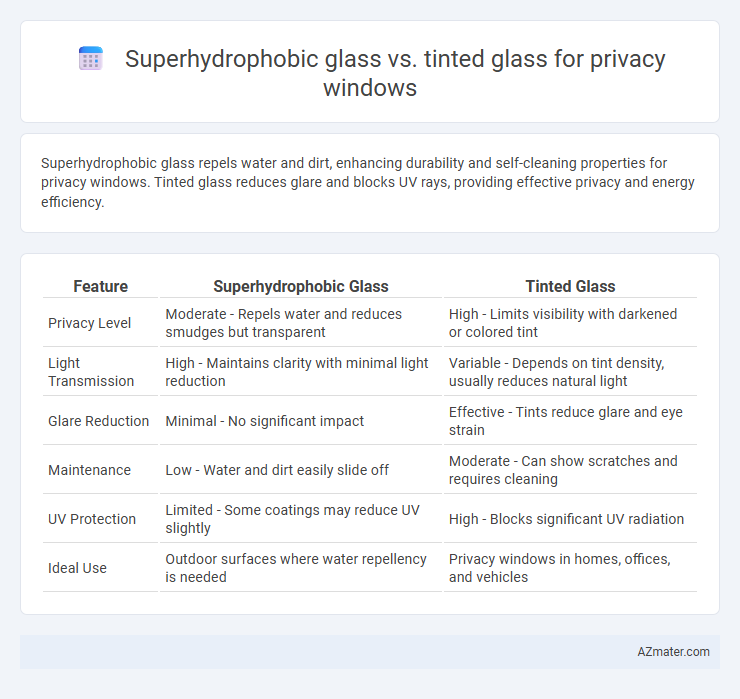Superhydrophobic glass repels water and dirt, enhancing durability and self-cleaning properties for privacy windows. Tinted glass reduces glare and blocks UV rays, providing effective privacy and energy efficiency.
Table of Comparison
| Feature | Superhydrophobic Glass | Tinted Glass |
|---|---|---|
| Privacy Level | Moderate - Repels water and reduces smudges but transparent | High - Limits visibility with darkened or colored tint |
| Light Transmission | High - Maintains clarity with minimal light reduction | Variable - Depends on tint density, usually reduces natural light |
| Glare Reduction | Minimal - No significant impact | Effective - Tints reduce glare and eye strain |
| Maintenance | Low - Water and dirt easily slide off | Moderate - Can show scratches and requires cleaning |
| UV Protection | Limited - Some coatings may reduce UV slightly | High - Blocks significant UV radiation |
| Ideal Use | Outdoor surfaces where water repellency is needed | Privacy windows in homes, offices, and vehicles |
Introduction to Privacy Window Solutions
Privacy window solutions include superhydrophobic glass and tinted glass, each offering distinct benefits for enhancing indoor seclusion. Superhydrophobic glass repels water and dirt, maintaining clear visibility while providing subtle privacy through light diffusion. Tinted glass reduces visibility from the outside by controlling light transmission and glare, making it an effective option for maintaining privacy without compromising natural light.
Understanding Superhydrophobic Glass Technology
Superhydrophobic glass technology enhances privacy windows by repelling water and preventing smudges, maintaining clear visibility while reducing maintenance. Unlike tinted glass that relies on darkening film or coatings to block light and visibility, superhydrophobic glass offers self-cleaning properties and retains natural light transmission. This advanced nanoscale surface treatment creates a highly water-repellent layer, improving window hygiene and durability without compromising transparency or privacy.
What Is Tinted Glass and How Does It Work?
Tinted glass is manufactured by adding metal oxides or dyes during the glass production process, which absorbs and reduces the amount of visible light and UV rays passing through the window. This type of glass provides privacy by limiting visibility from the outside while maintaining some level of natural light inside. Its ability to control solar heat gain also enhances energy efficiency and reduces glare.
Privacy Performance: Superhydrophobic vs Tinted Glass
Superhydrophobic glass offers enhanced privacy by repelling water and reducing smudges, which maintains clearer visibility from the inside while obscuring the view from outside under wet conditions. Tinted glass provides consistent privacy by reducing light transmission and glare, effectively limiting visibility regardless of weather or lighting. In terms of privacy performance, tinted glass generally delivers more reliable and continuous privacy than superhydrophobic glass, especially in dry conditions.
Daylight Transmission and Visual Clarity
Superhydrophobic glass maintains high daylight transmission, typically above 80%, enabling clear and bright indoor environments while repelling water and dirt for sustained visibility. Tinted glass reduces daylight transmission significantly, often ranging from 15% to 50%, which lowers glare but can compromise visual clarity and natural light levels. For privacy windows, superhydrophobic glass provides superior clarity without sacrificing brightness, whereas tinted glass balances privacy with reduced light, impacting color perception and indoor ambiance.
Energy Efficiency Considerations
Superhydrophobic glass features a nanoscale coating that repels water and reduces surface contaminants, enhancing natural light transmission while maintaining energy efficiency by minimizing heat absorption. Tinted glass reduces solar heat gain by absorbing and reflecting a portion of sunlight, which lowers cooling costs in hot climates but can decrease visible light, potentially increasing reliance on artificial lighting. Choosing between superhydrophobic and tinted glass for privacy windows depends on balancing the need for transparency, natural light entry, and thermal insulation to optimize overall energy performance.
Durability and Maintenance Comparison
Superhydrophobic glass features a nano-coating that repels water and dirt, greatly reducing maintenance efforts and enhancing durability against environmental pollutants and weathering, making it ideal for long-term privacy window applications. Tinted glass, while effective in reducing glare and offering privacy by limiting visibility, may degrade faster under prolonged UV exposure and typically requires regular cleaning to maintain clarity and performance. The superior self-cleaning properties and resistance to staining of superhydrophobic glass often result in lower upkeep and extended lifespan compared to conventional tinted glass.
Cost Analysis: Superhydrophobic vs Tinted Glass
Superhydrophobic glass typically incurs higher initial costs due to advanced nanocoating technologies that repel water and contaminants, reducing maintenance expenses over time. Tinted glass offers lower upfront pricing, primarily focusing on UV protection and glare reduction without addressing cleanliness or water repellency. When evaluating total cost of ownership, superhydrophobic glass may deliver better long-term value in privacy windows by minimizing cleaning frequency and preserving clarity compared to more affordable but maintenance-intensive tinted glass options.
Aesthetic Impact on Architectural Design
Superhydrophobic glass enhances architectural aesthetics by maintaining clarity and brightness while repelling water and dirt, preserving the window's pristine look without compromising natural light. Tinted glass offers effective privacy by reducing visibility from the outside, but its darker hues can alter the building's visual appeal and reduce interior daylight. Choosing between the two depends on balancing the need for unobstructed views and brightness with privacy requirements and the desired exterior color palette.
Choosing the Right Option for Your Privacy Needs
Superhydrophobic glass offers enhanced privacy by repelling water and dirt to maintain clear visibility while providing a subtle, natural opacity that prevents outside views. Tinted glass reduces glare and blocks UV rays with varying levels of darkness to ensure effective privacy by limiting visibility from outside. Choosing between superhydrophobic and tinted glass depends on whether you prioritize self-cleaning benefits with moderate privacy or stronger light control with higher opacity for maximum confidentiality.

Infographic: Superhydrophobic glass vs Tinted glass for Privacy window
 azmater.com
azmater.com